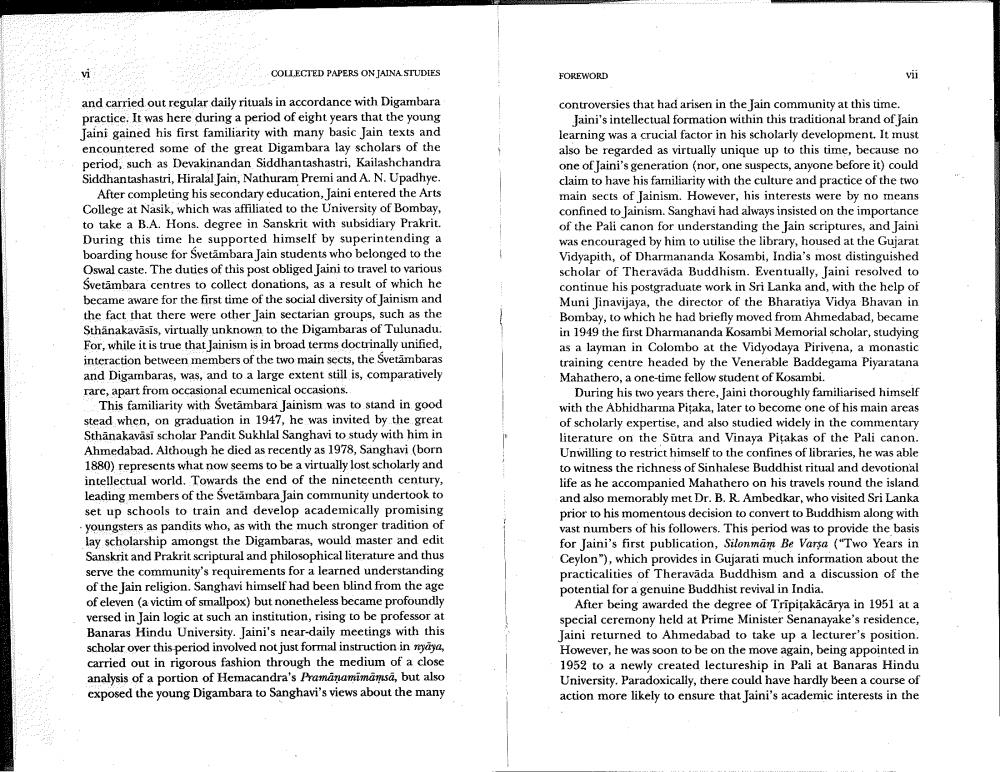________________
COLLECTED PAPERS ON JAINA STUDIES
FOREWORD
vii
and carried out regular daily rituals in accordance with Digambara practice. It was here during a period of eight years that the young Jaini gained his first familiarity with many basic Jain texts and encountered some of the great Digambara lay scholars of the period, such as Devakinandan Siddhantashastri, Kailashchandra Siddhantashastri, Hiralal Jain, Nathuram Premi and A. N. Upadhye.
After completing his secondary education, Jaini entered the Arts College at Nasik, which was affiliated to the University of Bombay, to take a B.A. Hons. degree in Sanskrit with subsidiary Prakrit. During this time he supported himself by superintending a boarding house for Svetämbara Jain students who belonged to the Oswal caste. The duties of this post obliged Jaini to travel to various Svetämbara centres to collect donations, as a result of which he became aware for the first time of the social diversity of Jainism and the fact that there were other Jain sectarian groups, such as the Sthanakavāsis, virtually unknown to the Digambaras of Tulunadu. For, while it is true that Jainism is in broad terms doctrinally unified, interaction between members of the two main sects, the Svetambaras and Digambaras, was, and to a large extent still is, comparatively rare, apart from occasional ecumenical occasions.
This familiarity with Svetämbara Jainism was to stand in good stead when, on graduation in 1947, he was invited by the great Sthanakavasi scholar Pandit Sukhlal Sanghavi to study with him in Ahmedabad. Although he died as recently as 1978, Sanghavi (born 1880) represents what now seems to be a virtually lost scholarly and intellectual world. Towards the end of the nineteenth century, leading members of the Svetambara Jain community undertook to set up schools to train and develop academically promising youngsters as pandits who, as with the much stronger tradition of lay scholarship amongst the Digambaras, would master and edit Sanskrit and Prakrit scriptural and philosophical literature and thus serve the community's requirements for a learned understanding of the Jain religion. Sanghavi himself had been blind from the age of eleven (a victim of smallpox) but nonetheless became profoundly versed in Jain logic at such an institution, rising to be professor at Banaras Hindu University. Jaini's near-daily meetings with this scholar over this period involved not just formal instruction in niya, carried out in rigorous fashion through the medium of a close analysis of a portion of Hemacandra's Pramanamimus, but also exposed the young Digambara to Sanghavi's views about the many
controversies that had arisen in the Jain community at this time.
Jaini's intellectual formation within this traditional brand of Jain learning was a crucial factor in his scholarly development. It must also be regarded as virtually unique up to this time, because no one of Jaini's generation (nor, one suspects, anyone before it) could claim to have his familiarity with the culture and practice of the two main sects of Jainism. However, his interests were by no means confined to Jainism. Sanghavi had always insisted on the importance of the Pali canon for understanding the Jain scriptures, and Jaini was encouraged by him to utilise the library, housed at the Gujarat Vidyapith, of Dharmananda Kosambi, India's most distinguished scholar of Theravada Buddhism. Eventually, Jaini resolved to continue his postgraduate work in Sri Lanka and, with the help of Muni Jinavijaya, the director of the Bharatiya Vidya Bhavan in Bombay, to which he had briefly moved from Ahmedabad, became in 1949 the first Dharmananda Kosambi Memorial scholar, studying as a layman in Colombo at the Vidyodaya Pirivena, a monastic training centre headed by the Venerable Baddegama Piyaratana Mahathero, a one-time fellow student of Kosambi.
During his two years there, Jaini thoroughly familiarised himself with the Abhidharma Pitaka, later to become one of his main areas of scholarly expertise, and also studied widely in the commentary literature on the Sutra and Vinaya Pitakas of the Pali canon. Unwilling to restrict himself to the confines of libraries, he was able to witness the richness of Sinhalese Buddhist ritual and devotional life as he accompanied Mahathero on his travels round the island and also memorably met Dr. B. R. Ambedkar, who visited Sri Lanka prior to his momentous decision to convert to Buddhism along with vast numbers of his followers. This period was to provide the basis for Jaini's first publication, Silonmam Be Varsa ("Two Years in Ceylon"), which provides in Gujarati much information about the practicalities of Theravada Buddhism and a discussion of the potential for a genuine Buddhist revival in India.
After being awarded the degree of Tripitakācārya in 1951 at a special ceremony held at Prime Minister Senanayake's residence, Jaini returned to Ahmedabad to take up a lecturer's position. However, he was soon to be on the move again, being appointed in 1952 to a newly created lectureship in Pali at Banaras Hindu University. Paradoxically, there could have hardly been a course of action more likely to ensure that Jaini's academic interests in the




